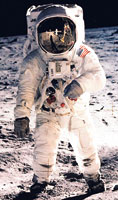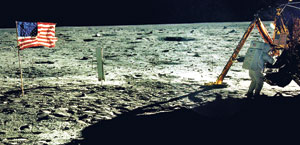Knots of people clustered around the radio, listening intently all over the world including Sri Lanka. Those were the days long before television when historic news was broadcast over crackling radio waves.
It was a first for the world. As people listened with bated breath, those famous words resounded across the globe……. “One small step for man, one giant leap for mankind,” said Neil Armstrong, moments after he set foot on the moon.
 |
| Astronaut Edwin Aldrin Jr., lunar module pilot, walking on the surface of the moon. AFP |
He was followed by astronaut, Edwin (Buzz ) Aldrin, stepping off the lunar-landing module ‘Eagle’ as Michael Collins orbited above. They left a plaque behind with the words: “Here men from the planet Earth first set foot on the Moon -- July 1969 A.D. We came in peace for all mankind.”
That was July 20, 1969 and as the world celebrates the 40th anniversary of the moon-landing tomorrow, the Sunday Times went down the corridors of time.
The mission to the moon on Apollo 11 left Florida, USA, on July 16 and returned on July 24. “I didn’t budge from my seat,” smiles Punya Hettiarachchi who was 15 years old at the time Armstrong stepped onto the moon. He sat next to the radio throughout listening to what was happening.
Nandani Abeywardane recalls how she listened to the step-by-step commentary of the landing, surrounded by her parents and siblings. People don’t seem to feel the same excitement that we experienced that day over anything which happens now, she says.
Another person, who was 23 at that time, said enthusiastically, “It was a historic moment. It was a complete surprise. No one knew it was possible, but it happened.”
Nineteen at the time and an avid space fan, who grew up with fantasies of Unidentified Flying Objects, Wasantha Kotuwella, says he jumped up in glee when Armstrong took the first step on the moon. “I believed that I will be picked up by an UFO. To me, the landing on the moon was a step towards that.”
We were in the school hostel, a group of students, listening to the radio, hanging on to every word, adds Hemantha Subasinghe.
Those who were away from their radios had to make do with the newspapers. ‘Eagle blasts off!’ screamed the banner headline of the Daily News of July 21, 1969 while an article in the Dinamina of July 22, explained how the astronauts floated — or in reality jumped around like kangaroos due to lack of gravitation — on the moon for a few hours, got rock samples, had two meals and seven hours of sleep.
 |
| This July 20, 1969 file photo released by NASA shows commander of the Apollo 11 mission Neil Armstrong of the US near the lunar lander and the US flag - AFP |
Forty years hence, space technology has evolved in leaps and bounds, with scientists even attempting inter-planetary travel, though not yet successful. Space probes have flown by all of the planets of the solar system from Mercury to Neptune. Remotely-controlled landers have landed on the surface of Mars. Many astronomers believe that exploration of the solar system provides knowledge not be gained by observations from the Earth's surface or its orbit.
The management of fuel for travelling in outer space - and essentially the supply of oxygen, nitrogen and other gases have been some of the key problems in the development of space travel.
Inspiration of scientists and fantasies of children have come a long way since the moon-landing, with future hopes of seeing another moment much like it, though its magnitude cannot be replicated.
Lecture on the moon-landing
A lecture on the moon-landing by Prof. Chandana Jayaratne of the University of Colombo will be jointly hosted by the Arthur C. Clarke Institute and the American Embassy at 3.30 p.m. tomorrow at the institute auditorium.
A short documentary on the ‘50-year anniversary of NASA’ will also be shown at 4 p.m. courtesy of the American Embassy.
Entrance to the event is free. |


